Europe is known for its historic destinations, and they don’t get much more historic than Athens, Greece’s ancient capital city. Amazingly, much of its long history is still visible, thanks to the many ancient landmarks that have survived. Athens has long attracted tourists keen to see these ancient wonders with their own eyes. If you follow this Athens itinerary, you can experience all these marvels with just two days in the city.
Best Time to Visit Athens
The timing of your visit to any destination can play a big part in your enjoyment of that place. As with other popular places in Southern Europe, such as Rome or Florence, the best time to visit Athens is typically during the shoulder season, which runs from April to May and September to early November. These are the times of the year when the weather is nice and tourist numbers aren’t too high. It’s also the best time to combine Athens with a trip to the Greek islands.
Athens is busiest with tourists in the summer, even though locals typically go on vacation in August. The extreme heat can also be a deterrent.
While other parts of Greece (such as the islands) aren’t much fun in winter, Athens is a little different. It gets somewhat cold and even snows occasionally, but you can still do all the historic and cultural sightseeing and won’t encounter many crowds.
How to Get Around Athens
Though Athens is an ancient city, it’s not actually that big or spread out. Most of the major attractions are within the same few neighborhoods, so walking between them isn’t a problem.
Of course, while you’re visiting Athens, there may be times when you get tired of walking or it’s not the best way to get where you need to go. Thankfully, the city has a network of metro trains, buses, and trams that will help you get around easily during your 48 hours in Athens. Probably the most useful form of public transport is the metro network, with its three lines linking the city center to other popular areas.
The Ath.ena system offers multiple types of rechargeable tickets, but the cheapest is a 90-minute trip for €1.40 (about $1.54). Although one of the metro lines runs between Athens International Airport and Syntagma Square, you need a special €10 ticket for the 40-minute journey. The cheaper way to get to and from the airport is its €6 express bus, but its travel time can be up to 70 minutes.
If you’re coming by ferry, you’ll arrive in Piraeus, the next city over from Athens. Thankfully, Piraeus is also connected to the city center by metro, so reaching Athens from Piraeus isn’t difficult.
Recommendation: Another great way to explore Athens is on a hop-on hop-off bus tour. You get to see the best of the Greek capital’s famous sites while enjoying audio guide commentary as you ride.
Where to Stay in Athens
The decision of where to stay in Athens can have a big impact on your enjoyment of the trip. After all, you don’t want to travel far just to go sightseeing or find dinner. The best places to stay in Athens are central neighborhoods such as Plaka, Monastiraki, and Psyri, as they’re close to so many attractions. Kolonaki is another good choice, thanks to its bars, restaurants, and cafes.
For a luxurious stay in the center of Athens, treat yourself with a stay at the Electra Metropolis. Just a short walk from Syntagma Square, this five-star hotel features comfortable and spacious rooms, a rooftop pool, and terrace views of the Acropolis.
A midrange alternative is the Attalos Hotel, close to Monastiraki Square. It also has a nice rooftop garden and clean, spacious rooms with air conditioning while being more affordable than the Electra.
Another great option to consider for quality accommodation and vacation apartments is Airbnb. For recommendations, take a look at our list of the best Airbnbs in Athens.
If you have a strict budget but still want the city at your doorstep, City Circus Athens in Psyri is the place for you. It provides boutique style and cleanliness at backpacker rates and even has its own on-site restaurant. For more recommendations, see our guide to the best hostels in Athens.
For more accommodation options in Athens, check out Booking.com. This site consistently offers the best rates, and its customer service is on point.
The Perfect 2-Day Athens Itinerary
While there’s plenty to see and do in the city for a longer visit, it’s certainly possible to cover the best places to visit in Athens in two days. Our itinerary will take you through the best of Athens, showing how to explore the highlights in the city’s ancient center and take in a few interesting neighborhoods along the way. While this visit will include a lot of ancient attractions, you’ll also get a feel for life in Athens and enjoy some spectacular views.
However, before we get to our Athens itinerary and the best things to do in Athens, we just wanted to remind you to purchase travel insurance. You never know what will happen and, trust us, you do not want to get stuck with thousands of dollars in medical bills. As a wise man once said, “If you can’t afford travel insurance, you can’t afford to travel.” So don’t leave home without it.
SafetyWing offers travel insurance for only about $10 a week, making it a no-brainer to get. You can get a quick, non-binding quote below:

SafetyWing is, of course, not the only option available. Two other popular alternatives are World Nomads and Heymondo.
With that important point covered, it’s time to delve into our Athens travel itinerary. Let’s see what to do in Athens in two days!
Athens Itinerary: Day 1
With only a weekend in Athens, it makes sense to start with the most popular attractions. We’ll begin at the center, covering historic sites around the Acropolis. Prepare for a day of ancient ruins and pretty streets!
Monastiraki Square
To get a quick sense of the city, start at Monastiraki Square. From this central plaza, you’ll catch a glimpse of the Acropolis rising above the city. Monastiraki Square also has its own landmarks worth checking out, such as the historic Church of the Pantanassa, the Ottoman Tzistarakis Mosque, and the considerably older Roman ruins of Hadrian’s Library.
But what Monastiraki Square and the wider neighborhood are most known for is shopping. Just off the square is the Monastiraki Flea Market, a series of pedestrian shopping streets where you can buy souvenirs, clothes, religious icons, and more.

Streets of Plaka and Anafiotika
Head clockwise from Monastiraki around the hill of the Acropolis to soak up the charm of Plaka. This historic neighborhood sits directly below the Acropolis and is a maze of some of Athens’ most picturesque streets.
Paved with stone and tiles, these narrow pedestrian streets often have vibrant bougainvillea and other flowers creeping up the walls and hanging overhead. You’ll also see some scenic staircases that link the different levels of the neighborhood, as well as classic tavernas and cafes with outdoor seating.
You should also explore Anafiotika, a delightful little neighborhood within the Plaka area, below the northeastern edge of the Acropolis. This area is known for its charming little houses and whitewashed exteriors that resemble the homes on the Greek islands. This is because the original residents of Anafiotika tended to be islanders from the Cyclades who moved to Athens for work.

Ruins of the Acropolis
Wherever you are in Athens, the Acropolis is a constant presence. This ancient citadel on a rocky outcrop was the center of Athens for millennia, and the ruins are still there to prove it. Many of the city’s famous landmarks were built there, starting back in the fifth century B.C. Visiting the Acropolis is undoubtedly one of the best things to do in Athens and an experience you simply can’t miss.
Recommendation: You’ll get more out of your visit to the Acropolis if you book a tour with a knowledgeable guide. There are no signs at the Acropolis, so unless you’re well versed in Greek history and mythology, it’s hard to figure out what you’re looking at on your own.
As you climb the hill of the Acropolis, you’ll encounter two impressive landmarks in their own right: the Theatre of Dionysus and the Odeon of Herodes Atticus. Set into the hillside, the Dionysus is made up of a semicircle of marble seats facing the stage. Though this isn’t confirmed, it might well have been the world’s first theater. The Odeon is another stone theater on the same side of the hill, but far better preserved and restored than the Dionysus, with a full stone back wall. In fact, the Odeon is used for concerts to this day.
Once you reach the Acropolis, you’ll see three main landmarks (not to mention the fantastic views from the citadel walls). The first is the hill’s western gateway, the Propylaea, which you’ll pass through to reach the top. Next is the Parthenon, ruins of an ancient temple and perhaps the most famous attraction in Athens.
North of the Parthenon is the Erechtheion, a remarkably intact ancient temple featuring the artful Porch of the Caryatids. Make sure to find the Sacred Olive Tree while you’re here. According to legend, this is a descendant of the original olive tree that the goddess Athena planted there herself.
Recommendation: Given the number of historic sites you’ll visit on this trip, it may be a good idea to purchase a combined or package ticket, rather than a ticket for just the Acropolis. If you visit in winter, though, it will likely be cheaper to buy your Acropolis ticket separately, as its prices are lower in winter.
Related: How to Buy Tickets to the Acropolis in Athens

Acropolis Museum
While the ruins are fresh in your mind, head over to the amazingly in-depth Acropolis Museum to grasp the history of everything you’ve just seen. It features exhibits for different parts of the Acropolis, such as the Gallery of the Slopes and the Parthenon Gallery, as well as sections that focus on specific time periods, including the Archaic Acropolis Gallery. You’ll find statues, sculptures, friezes, and even ancient everyday items like perfume bottles. Be warned – you might spend hours here!
Recommendation: Ticket lines for the Acropolis Museum can get quite long, especially during high season, so buy your skip-the-line ticket online in advance.
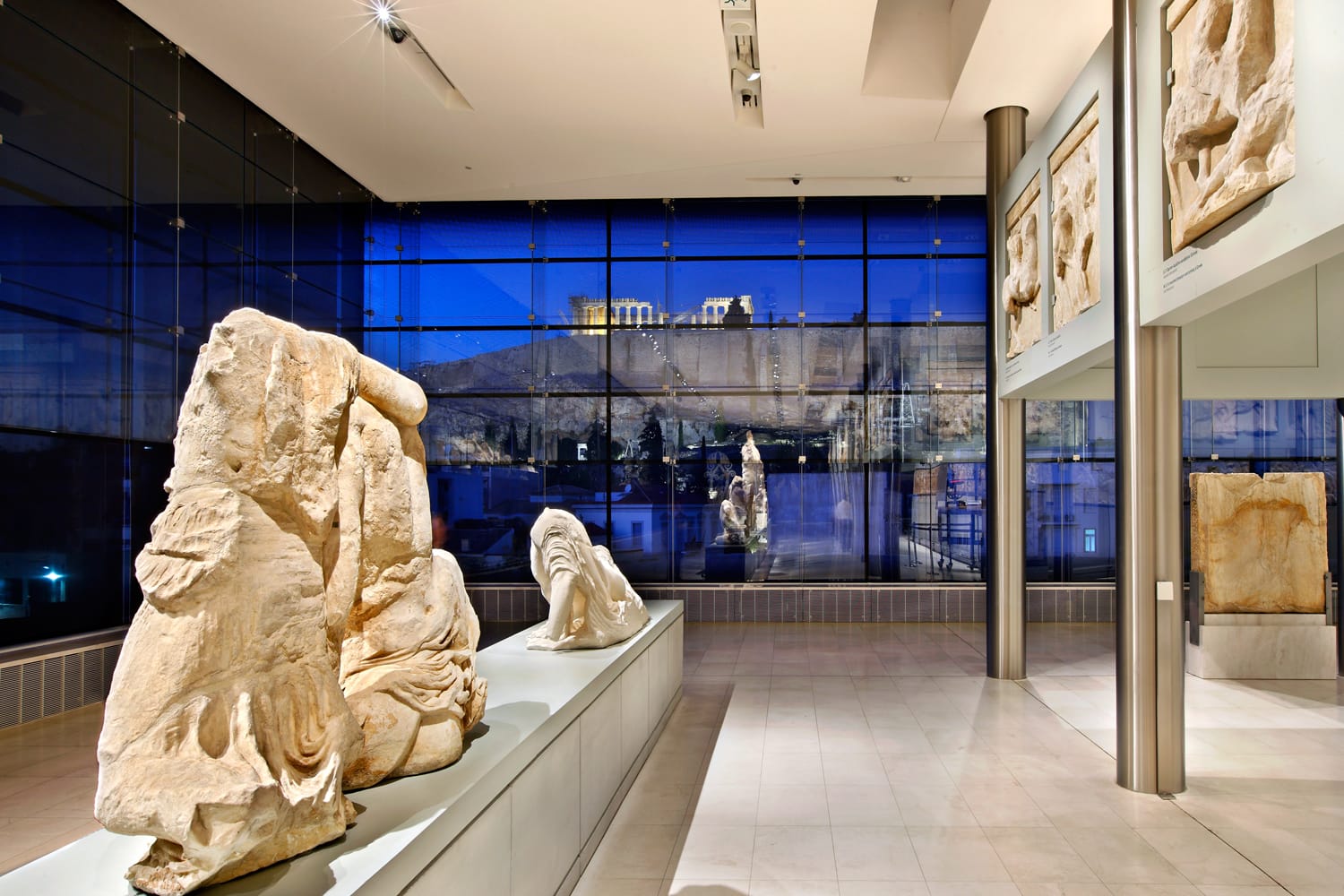
Ancient Agora
After the landmarks of the Acropolis, the most famous area for ancient ruins in Athens is the Agora. As the central marketplace and gathering spot, the Agora was the beating heart of ancient Athens. Thanks to the excavations and re-creations, you can get an idea of just how extensive it once was.
Many of the Agora’s ruins, such as the Odeon of Agrippa, are outlines of their former selves at best, retaining only a few columns or statues. However, two big landmarks are still standing: the Stoa of Attalos and the Temple of Hephaestus. Featuring a long row of columns, the Stoa of Attalos was restored in the 1950s and now houses the Agora Museum.
The Temple of Hephaestus, meanwhile, has survived mostly intact, even though it was built in the fifth century B.C. This temple and other remains in the Agora really give you a sense of what a big and important city ancient Athens must have been.
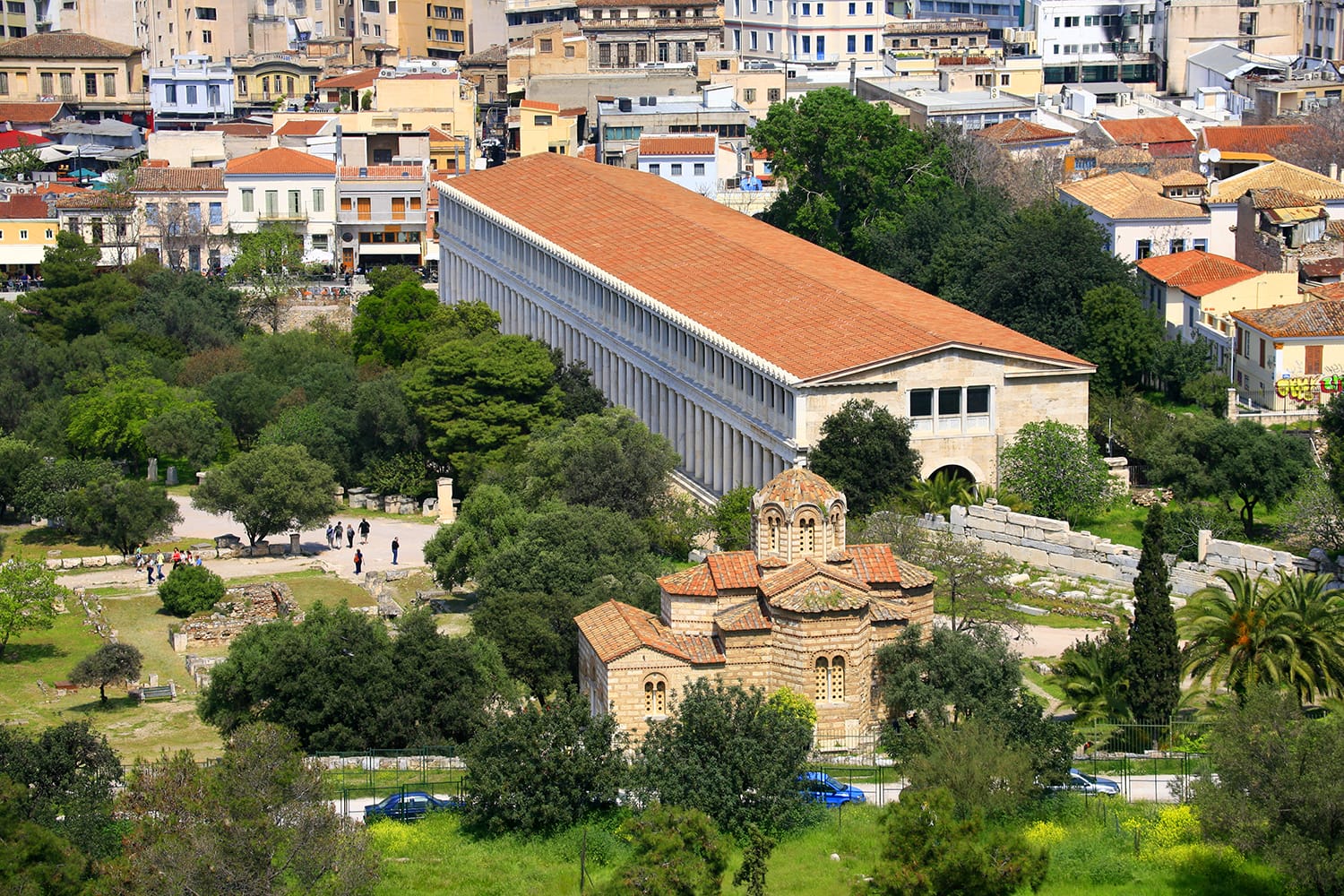
Kerameikos
We hope your energy for ancient sites isn’t ruined yet, because there’s one more to see before the day is over. A few hundred meters from the Agora is the sprawling ruin of another huge complex, Kerameikos. What makes Kerameikos a little different is that this area once straddled the city limits, so you’ll find ancient city walls and even the remains of a cemetery here. The small Kerameikos Archaeological Museum shows another side to ancient Greece, including artworks dating back to 860 B.C.
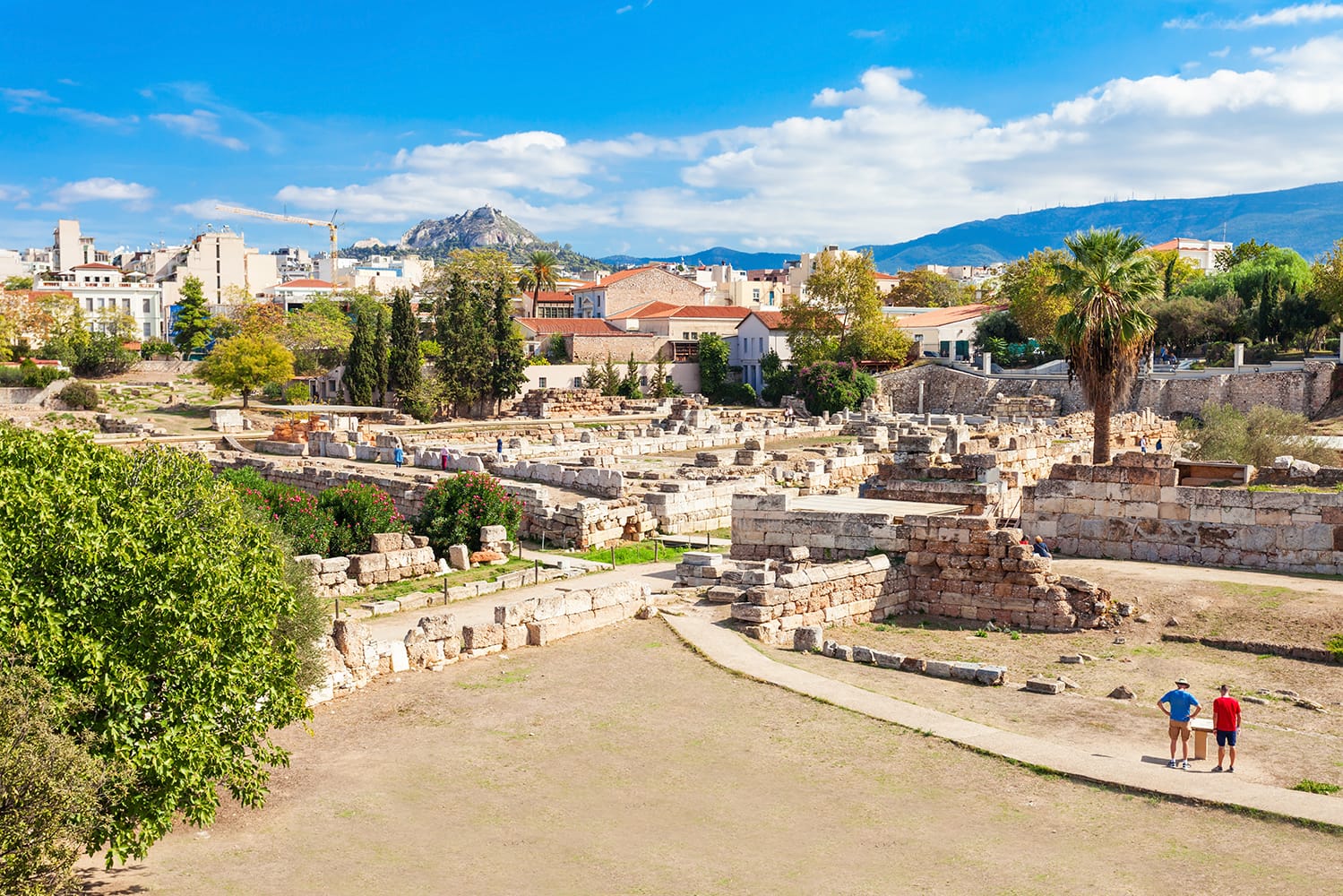
Sunset from Areopagus
After all that walking and history, it’s time to relax with a nice sunset view. While there are plenty of rooftops you could pay to go to, the best free viewpoint is the Areopagus. This rocky outcrop below the Acropolis is a popular and easily accessible spot, offering some beautiful views of the sunset and the city.

Athens Itinerary: Day 2
Your second day will give you a chance to explore beyond the ancient city center for a well-rounded feeling for what Athens is like. You’ll get to mix things up today, visiting both modern and ancient sites.
Syntagma Square
Perhaps the most famous square in all of Athens and the modern city’s most central point is Syntagma Square. Sitting right across from the Old Royal Palace, which houses the Hellenic Parliament, the square is named after Greece’s first constitution and has long held both social and political importance.
The plaza is both scenic and a good reference point, given the metro lines and buses that run from there. With its fountain, park atmosphere, and palace view, this is a pretty part of modern Athens. Cross to the front of the palace to watch the traditional changing of the guard at the Tomb of the Unknown Soldier outside.

Zappeion and National Garden
Behind the Old Royal Palace, you’ll find the sprawling National Garden, a park full of fountains, playgrounds, and walking trails. After so much time among city streets and tourist attractions, a stroll through the park is a nice change of pace. It’s here that you’ll also find the Zappeion, a 19th-century ceremonial building with a pleasant neoclassical look.
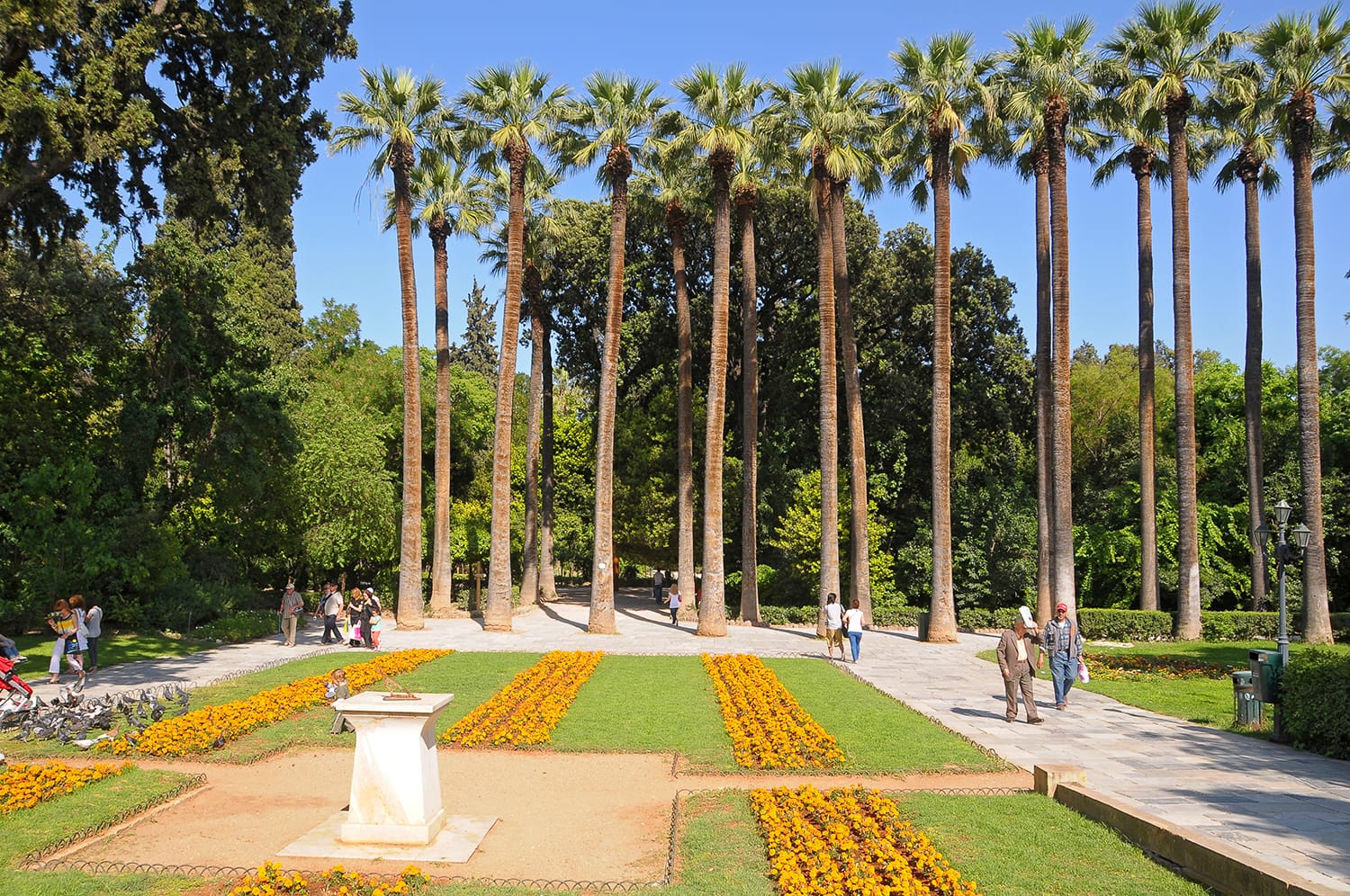
Panathenaic Stadium
Of ancient Greece’s many contributions to modern society, one of the most beloved is the Olympic Games held every four years. This ancient competition was revived in 1896, with Athens being the first city to host. One of the venues for those games was the Panathenaic Stadium, an ancient stadium that was excavated and revived much like the games were. Its other claim to fame is being the only stadium in the world made completely of marble.
Recommendation: If you’re looking for another view across Athens, climb to the top of stand 21 in the Panathenaic Stadium to see many of the city’s landmarks at once.
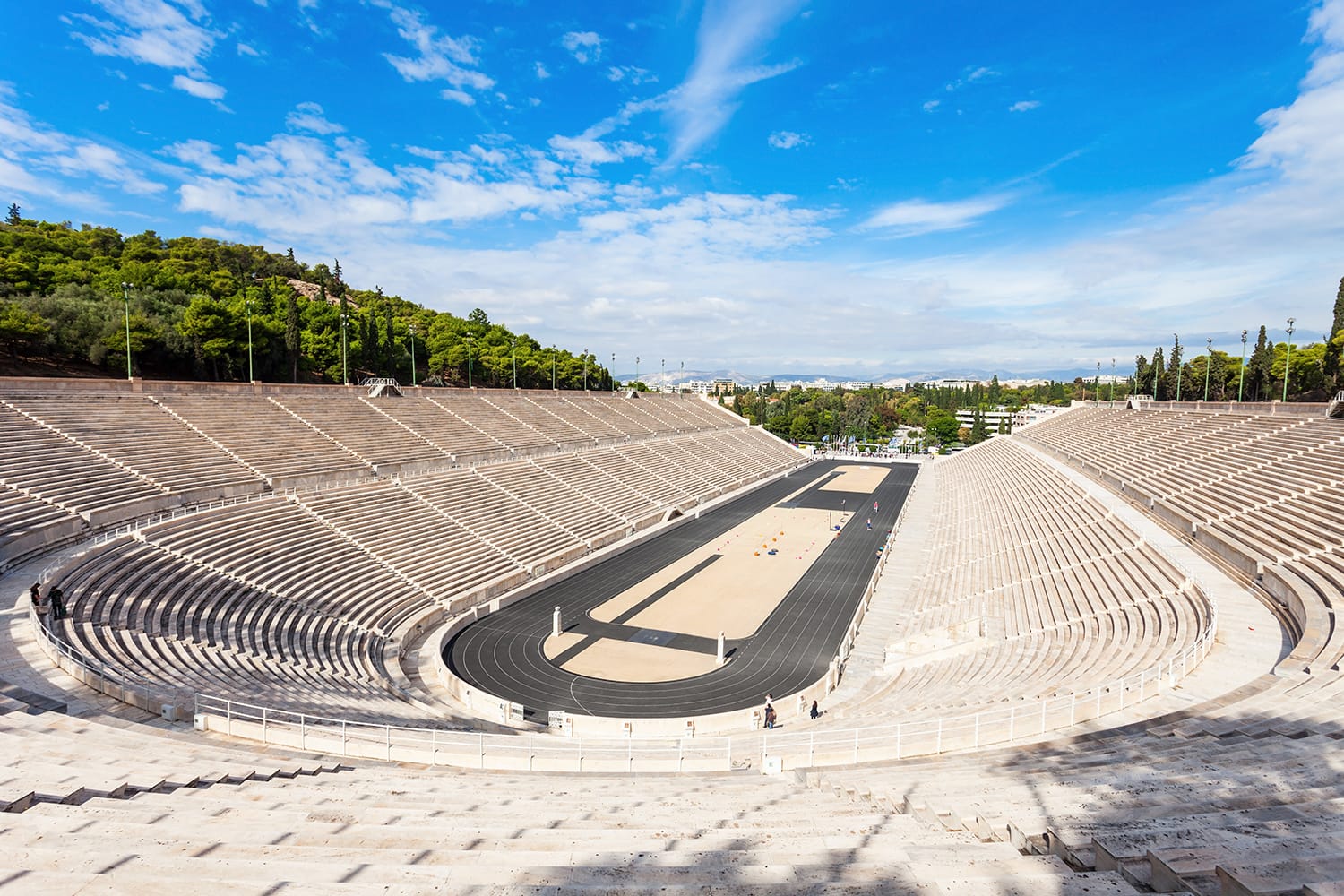
Temple of Olympian Zeus
Back across the road from the Zappeion is yet another ancient ruin, the Temple of Olympian Zeus. Whereas the Acropolis temples were dedicated to Athena and Poseidon, this temple was dedicated to Zeus, ruler of Olympus, the home of the gods. It took over 600 years for the temple to be completed in the second century A.D., but it was used for only 100 years before being abandoned.
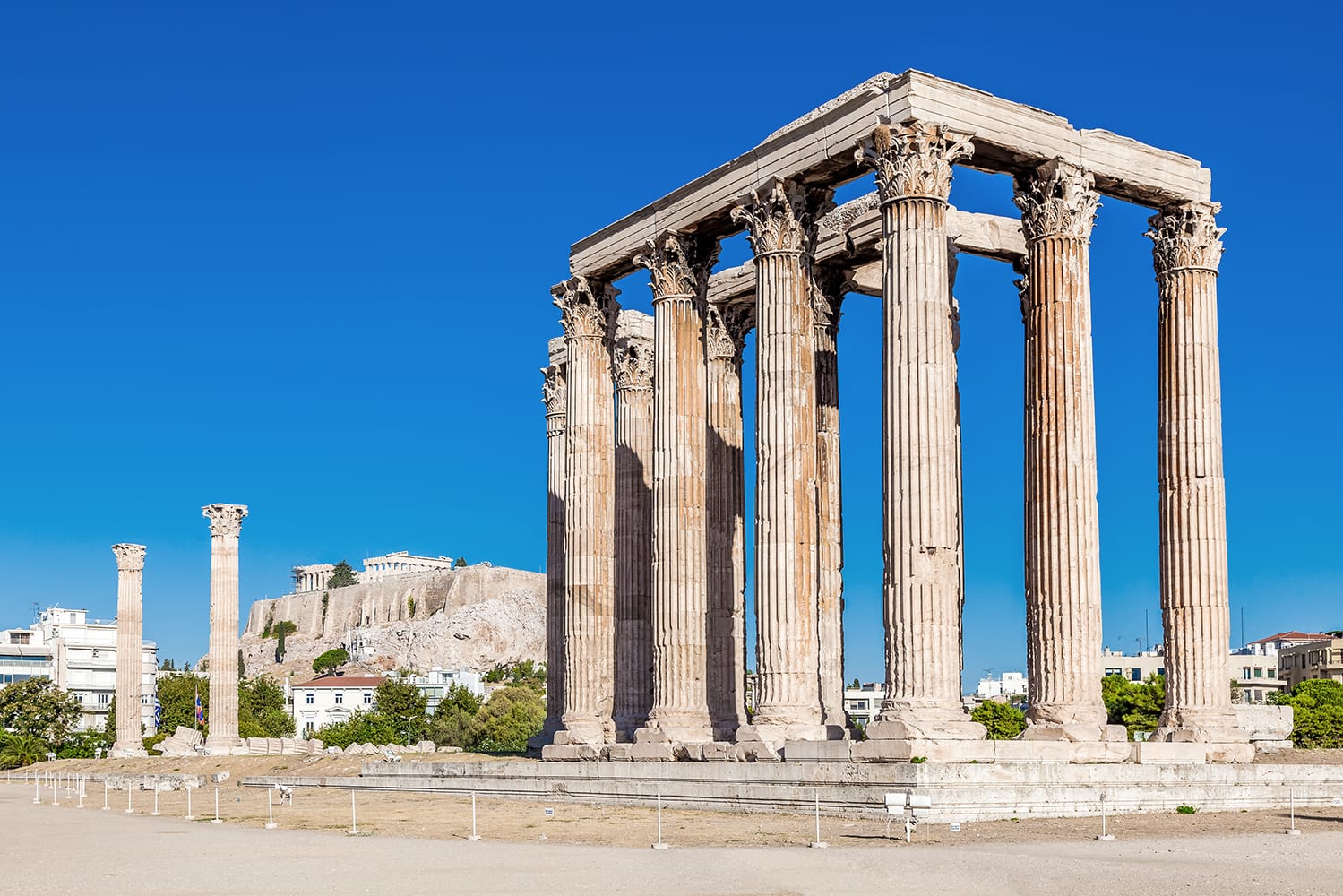
Roman Agora and Tower of the Winds
For one last stop in the ancient city, head back over near Monastiraki Square and find the Roman Agora. The Romans used this forum after invading Greece and starting to build over the Ancient Agora.
You’ll pass the still-standing Gate of Athena Archegetis, columns, and various remains here. The most important feature, though, is the Horologion of Andronikos Kyrrhestes, better known as the Tower of the Winds. This marble clock tower was basically an all-in-one weather station, with sundials, a weather vane, and a water clock – yet another sign of how advanced and ingenious the people of ancient Greece were.
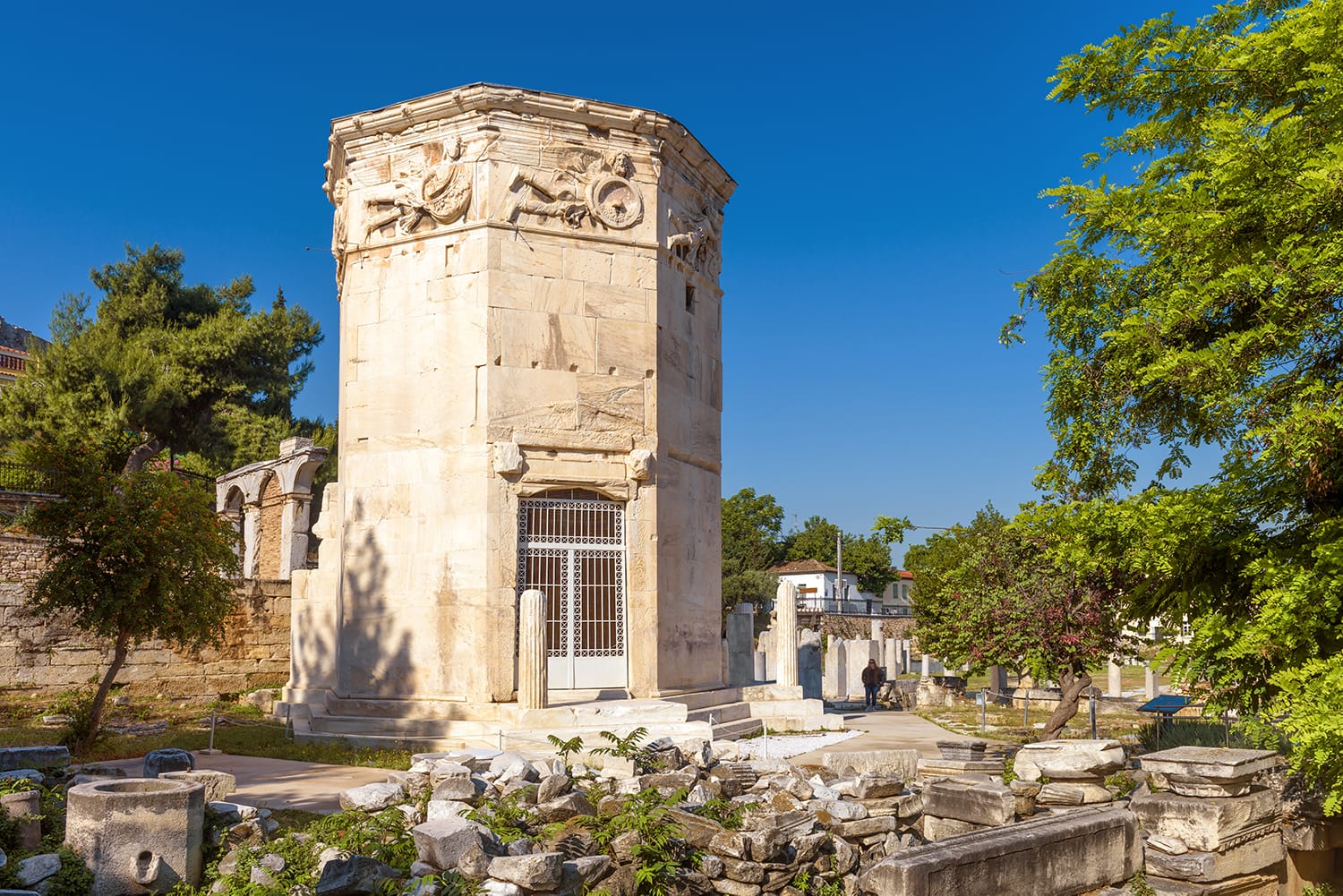
Kolonaki
Leaving the ancient center of Athens behind, make your way out to the lovely neighborhood of Kolonaki. Resting against Mount Lycabettus, this leafy neighborhood has some seriously steep streets but also plenty of bars, restaurants, and shopping. It’s a very different side of Athens from somewhere like Plaka, but still a good place for your last evening in the city!
Mount Lycabettus
The only major place left to go from Kolonaki is up Mount Lycabettus. Athens was built on seven hills, two of which you’ve already visited by going to the Acropolis and Areopagus. Mount Lycabettus is the third, and its peak is actually the highest point in Athens. This makes it an awesome viewpoint for the entire city. With good weather, you can see all the way out to the coastal city of Piraeus.
The top of Mount Lycabettus also features the little white Church of St. George and a fancy restaurant, Orizontes. You have two options for getting up there: a scenic but steep hike, which takes about 30-90 minutes, or the funicular, which is far gentler and quicker but skips the upward view by going through a tunnel.

Day 3 and Beyond
If you have more than two days in Athens, we highly recommend you take a trip outside the city and explore some of its surroundings. There are plenty of amazing sights not too far away that are worth adding to your Athens itinerary. To get you started, here are some of the most popular day tours from Athens:
- Delphi Day Trip from Athens
- Hydra, Poros, and Aegina Full-Day Cruise from Athens
- Mycenae and Epidaurus Full-Day Tour from Athens
- Temple of Poseidon and Cape Sounion Tour from Athens
There you have it – the ultimate Athens itinerary with all the sights and places you should visit to experience Athens in two days! No doubt you’ll leave this ancient wonder of a city with some great photos and memories.








Comments